| Listing 1 - 10 of 37 | << page >> |
Sort by
|
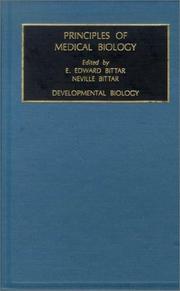
ISBN: 1559388161 9781559388160 9780080536125 0080536123 1281026832 9786611026837 Year: 1998 Volume: v. 11 Publisher: Greenwich, CT : JAI Press,
Abstract | Keywords | Export | Availability | Bookmark
 Loading...
Loading...Choose an application
- Reference Manager
- EndNote
- RefWorks (Direct export to RefWorks)
The purpose of this module is to provide a survey of the rapidly expanding field of developmental biology and to introduce it to the student in a unifying way. In medical schools where courses in biochemistry, physiology, and pharmacology are already considerably intersecting, there is not surprisingly a rising demand in modern medical education for books emphasizing the interdisciplinary approach. In recent years, developmental biology has become a very vibrant and exciting field. The adoption of the interdisciplinary approach in this field has yielded enormous information about how DNA is ab
General embryology. Developmental biology --- Molecular biology --- Developmental biology. --- Molecular biology. --- Cells --- Growth --- Regulation. --- Regulation of cell growth --- Biological control systems --- Cellular control mechanisms --- Molecular biochemistry --- Molecular biophysics --- Biochemistry --- Biophysics --- Biomolecules --- Systems biology --- Development (Biology) --- Biology --- Ontogeny
Book
ISBN: 0226281221 0122746023 0122746031 012274604X 0122746058 0122746066 0122746074 0122746082 0122746090 0122746104 0122746112 0122746120 0122746139 0471813583 0121027015 0121027023 0121027058 0121027066 0121027031 012102704X 9780122746130 9780122746062 9780122746055 9780471813583 9780122746031 9780226281223 9780122746024 9780122746109 9780122746086 9780122746116 9780122746093 9780122746123 9780122746048 9780122746079 9780121027056 9780121027018 9780121027025 0122746015 Year: 1968 Publisher: London Academic Press
Abstract | Keywords | Export | Availability | Bookmark
 Loading...
Loading...Choose an application
- Reference Manager
- EndNote
- RefWorks (Direct export to RefWorks)
MEDICINE --- Physiology, Pathological. --- Physiopathologie --- Herpetology --- Zoomorphology. Zooanatomy --- Reptiles --- Histology. Cytology --- Human medicine --- Biochemistry --- Cell Biology --- 57 --- Biologische wetenschappen in het algemeen. Biologie --- Biochemistry. --- Cell Biology. --- Medicine. --- Cytology. --- Physiology. --- Cytologie --- Physiologie --- Reptiles. --- Herpetofauna --- Herpetozoa --- Herps --- Herptiles --- Reptilia --- Sauria --- Amniotes --- Vertebrates

ISBN: 128107182X 9786611071820 0080528007 1559388196 9781559388191 9780080528007 9781281071828 6611071822 Year: 2000 Publisher: Stamford, Conn. JAI Press
Abstract | Keywords | Export | Availability | Bookmark
 Loading...
Loading...Choose an application
- Reference Manager
- EndNote
- RefWorks (Direct export to RefWorks)
It is now widely recognised that biological psychiatry is rapidly coming into its own. For over the last three decades dramatic advances in this young discipline have been made, all of which attest to the staying power of the experimental method. Those who made this revolution in knowledge happen are a breed of investigators availing themselves of the tools of molecular biology, pharmacology, genetics, and perhaps, above all, the technology of neuroimaging. The introduction of the interdisciplinary method of approach to the study of psychopathology had made it very clear that neuroimaging, as
Biological psychiatry. --- Brain --- Psychology, Pathological. --- Pathophysiology. --- Abnormal psychology --- Diseases, Mental --- Mental diseases --- Mental disorders --- Pathological psychology --- Psychology, Abnormal --- Psychopathology --- Cerebrum --- Mind --- Biopsychiatry --- Neurology --- Criminal psychology --- Mental health --- Psychiatry --- Psychoanalysis --- Central nervous system --- Head --- Psychobiology --- Diseases
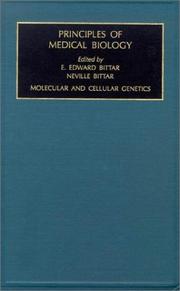
ISBN: 1281755001 9786611755003 0080536735 1559388099 9781559388092 9780080536736 Year: 1996 Publisher: Greenwich, CT : JAI Press,
Abstract | Keywords | Export | Availability | Bookmark
 Loading...
Loading...Choose an application
- Reference Manager
- EndNote
- RefWorks (Direct export to RefWorks)
The tools of molecular biology have revolutionised our understanding of gene structure and function and changed the teaching of genetics in a fundamental way. The transition from classical genetics to molecular genetics was initiated by two discoveries. One was the discovery that DNA has a complementary double helix structure and the other that a universal genetic code does exist. Both led to the acceptance of the central dogma that RNA molecules are made on DNA templates. The last twenty years have seen remarkable growth in our knowledge of molecular genetics, most of which is the outcome
Molecular genetics. --- Biochemical genetics. --- Chemical genetics --- Biochemistry --- Molecular genetics --- Genetics --- Molecular biology
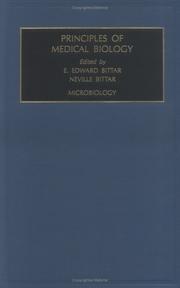
ISBN: 1281222763 0080539548 1559388145 9781559388146 Year: 1997 Publisher: Greenwich, Conn : JAI Press,
Abstract | Keywords | Export | Availability | Bookmark
 Loading...
Loading...Choose an application
- Reference Manager
- EndNote
- RefWorks (Direct export to RefWorks)
There is a need in small group teaching for a readable module that provides a balanced treatment of the four main areas of medical microbiology-bacteriology, mycology, virology and parasistology. It need not be encyclopedic in scope nor didactic, but it should emphasise principles and concepts. Any existing gaps in this type of presentation are, of course, left for the student to fill.Some subject material has been excluded. An example is a chapter on laboratory procedures including PCR for rapid bacterial and viral diagnosis. The discussion of bacterial sexually transmitted diseases does
Medical microbiology. --- Microbiology. --- Microbial biology --- Biology --- Microorganisms

ISBN: 1281057819 9786611057817 0080528759 1559388080 9781559388085 Year: 1996 Publisher: Greenwich, Conn. : JAI Press,
Abstract | Keywords | Export | Availability | Bookmark
 Loading...
Loading...Choose an application
- Reference Manager
- EndNote
- RefWorks (Direct export to RefWorks)
This volume is intended to complete the Cell Chemistry and physiology module. It is about how the traditional boundaries of cell chemistry and physiology are being erased by molecular biology. We do not think it necessary to elaborate on this theme, particularly since the body of core knowledge found in this volume brings us a stage closer to answering the question, ""what makes cell biology into a new discipline?""The first part of the volume deals with the chemistry of actin and myosin and is followed by chapters on cell motility, ATP synthesis in muscle, and contraction in smooth and sk
Cytochemistry. --- Cell physiology. --- Cell function --- Cytology --- Physiology --- Cell chemistry --- Biochemistry
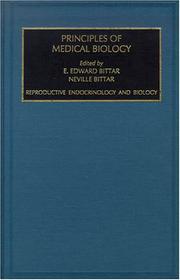
ISBN: 1281078271 9786611078270 0080544584 155938817X 9781559388177 9780080544588 Year: 1998 Publisher: Stamford, Conn. : JAI Press,
Abstract | Keywords | Export | Availability | Bookmark
 Loading...
Loading...Choose an application
- Reference Manager
- EndNote
- RefWorks (Direct export to RefWorks)
We have now reached the mid-point of our editorial task of putting together the compendium, Principles of Medical Biology, which is supposed to be composed of twenty-five modules. The present single-volume module on reproductive endocrinology and biology is in more than one respect a continuation of Module 10 (in two volumes) dealing with molecular and cellular endocrinology. In addition, it intersects, as it should, with various parts of obstetrics and gynaecology, both of which are abetted by technology.
Human reproduction --- Obstetrical endocrinology. --- Endocrine aspects. --- Endocrine obstetrics --- Hormonal aspects of pregnancy --- Obstetric endocrinology --- Pregnancy --- Endocrine gynecology --- Endocrinology --- Obstetrics --- Hormonal aspects of human reproduction --- Reproductive endocrinology --- Andrology --- Endocrine aspects --- Hormonal aspects

ISBN: 1281187003 9786611187002 0080528791 155938803X 9781559388030 9780080528793 1559388005 9781559388009 Year: 1995 Publisher: Greenwich, Conn. JAI Press
Abstract | Keywords | Export | Availability | Bookmark
 Loading...
Loading...Choose an application
- Reference Manager
- EndNote
- RefWorks (Direct export to RefWorks)
The purpose of this volume is to provide a synopsis of present knowledge of the structure, organisation, and function of cellular organelles with an emphasis on the examination of important but unsolved problems, and the directions in which molecular and cell biology are moving. Though designed primarily to meet the needs of the first-year medical student, particularly in schools where the traditional curriculum has been partly or wholly replaced by a multi-disciplinary core curriculum, the mass of information made available here should prove useful to students of biochemistry, physiology, bio
Cell organelles. --- Cytoplasm. --- Cells --- Protoplasm --- Organelles, Cell --- Cytoplasm

ISBN: 1281057797 9786611057794 0080531490 1559388048 9781559388047 9780080531496 9781559388009 1559388005 1559388005 Year: 1995 Publisher: Greenwich, CT : JAI Press,
Abstract | Keywords | Export | Availability | Bookmark
 Loading...
Loading...Choose an application
- Reference Manager
- EndNote
- RefWorks (Direct export to RefWorks)
This volume is in two parts. The first contains the remaining chapters on cellular organelles and several chapters relating to organelle disorders. An account of mitochondriopathis is given in the chapter on the mitochondrion rather than in a separate one. The subject matter of this part of the volume shows quite clearly that the interdisciplinary approach to the study of organelles has shed considerable light on the nature of the mechanisms underlying the etiology and pathobiology of many of these disorders. As an example, mutations in the genes encoding integral membrane proteins are found t
Cell organelles. --- Lysosomal storage diseases. --- Peroxisomal disorders. --- Extracellular matrix. --- Peroxisomal diseases --- Peroxisomes --- Peroxysomal disorders --- Central nervous system --- Metabolism, Inborn errors of --- Pediatric neurology --- Cell storage disorders --- Lysosomal disorders --- Lysosomal enzyme disorders --- Storage diseases, Lysosomal --- Organelles, Cell --- Cytoplasm --- Cement substance (Anatomy) --- Ground substance (Anatomy) --- Ground substance (Histology) --- Intercellular matrix --- Interstitial substance --- Matrix, Extracellular --- Connective tissues --- Extracellular space --- Diseases
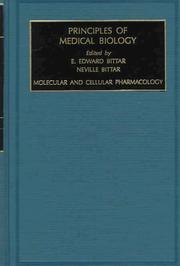
ISBN: 128103648X 9786611036485 0080509592 1559388137 9781559388139 1281036471 9786611036478 0080551165 1558607366 Year: 1997 Publisher: Greenwich, Conn. : JAI Press,
Abstract | Keywords | Export | Availability | Bookmark
 Loading...
Loading...Choose an application
- Reference Manager
- EndNote
- RefWorks (Direct export to RefWorks)
Molecular and Cellular Pharmacology
Cells. --- Drug receptors. Molecular pharmacology. Cells--Effect of drugs on. Receptors, Drug--metabolism. Neurotransmitters--pharmacology. Drug Therapy. Cells--drug effects. Steroids--chemistry. Vitamins--pharm. --- Effect of drugs on. --- Molecular pharmacology. --- Drug receptors --- Molecular pharmacology --- Cells --- Therapeutics --- Natural Science Disciplines --- Anatomy --- Molecular Mechanisms of Pharmacological Action --- Polycyclic Compounds --- Proteins --- Micronutrients --- Physiological Effects of Drugs --- Metabolic Phenomena --- Biological Science Disciplines --- Pharmacologic Actions --- Food --- Growth Substances --- Chemicals and Drugs --- Amino Acids, Peptides, and Proteins --- Disciplines and Occupations --- Analytical, Diagnostic and Therapeutic Techniques and Equipment --- Phenomena and Processes --- Chemical Actions and Uses --- Food and Beverages --- Technology, Industry, Agriculture --- Neurotransmitter Agents --- Vitamins --- Chemistry --- Receptors, Drug --- Steroids --- Drug Therapy --- Metabolism --- Pharmacology --- Health & Biological Sciences --- Pharmacy, Therapeutics, & Pharmacology --- Effect of drugs on --- Pharmacologies --- Pharmaceutical Preparations --- Metabolic Phenomenon --- Metabolic Process --- Metabolism Concepts --- Metabolism Phenomena --- Process, Metabolic --- Processes, Metabolic --- Anabolism --- Catabolism --- Metabolic Concepts --- Metabolic Processes --- Concept, Metabolic --- Concept, Metabolism --- Concepts, Metabolic --- Concepts, Metabolism --- Metabolic Concept --- Metabolism Concept --- Phenomena, Metabolic --- Phenomena, Metabolism --- Phenomenon, Metabolic --- Therapy, Drug --- Chemotherapy --- Pharmacotherapy --- Chemotherapies --- Drug Therapies --- Pharmacotherapies --- Therapies, Drug --- Disease --- Cell --- Cell Biology --- Catatoxic Steroids --- Steroids, Catatoxic --- Drug Receptor --- Drug Receptors --- Receptor, Drug --- Vitamin --- Nerve Transmitter Substances --- Neurohormones --- Neurohumors --- Neuromodulator --- Neuromodulators --- Neuroregulator --- Neuroregulators --- Neurotransmitter --- Neurotransmitters --- Substances, Nerve Transmitter --- Transmitter Substances, Nerve --- Neurotransmitter Agent --- Neurotoxins --- Beverages and Food --- Mitogens, Endogenous --- Endogenous Mitogens --- Agricultural Inoculants --- Foods --- Nutritional Physiological Phenomena --- Nutritional Requirements --- Chemical Actions --- Actions, Chemical --- Actions, Pharmacologic --- Pharmacological and Toxicological Phenomena --- Biologic Sciences --- Biological Science --- Science, Biological --- Sciences, Biological --- Biological Sciences --- Life Sciences --- Biologic Science --- Biological Science Discipline --- Discipline, Biological Science --- Disciplines, Biological Science --- Life Science --- Science Discipline, Biological --- Science Disciplines, Biological --- Science, Biologic --- Science, Life --- Sciences, Biologic --- Sciences, Life --- Drug Effects on Physiology --- Drug Physiological Effects --- Effects, Drug Physiological --- Physiological Effects, Drug --- Micronutrient --- Gene Products, Protein --- Gene Proteins --- Protein Gene Products --- Proteins, Gene --- Compounds, Polycyclic --- Hydrocarbons, Cyclic --- Pharmacological Mechanisms of Action --- Anatomies --- Natural Sciences --- Physical Sciences --- Discipline, Natural Science --- Disciplines, Natural Science --- Natural Science --- Natural Science Discipline --- Physical Science --- Science, Natural --- Science, Physical --- Sciences, Natural --- Sciences, Physical --- Therapy --- Treatment --- Therapeutic --- Therapies --- Treatments --- Organisms --- Cytology --- Molecular biology --- Drugs --- Cell receptors --- pharmacology --- drug therapy --- therapeutic use --- therapy --- Receptors --- Steroid --- Nerve Transmitter Substance --- Neurohormone --- Neurohumor --- Substance, Nerve Transmitter --- Transmitter Substance, Nerve --- Food And Beverage --- And Beverage, Food --- And Beverages, Food --- Beverage, Food And --- Beverages, Food And --- Protein --- Database management. --- Internet programming. --- Java (Computer program language). --- Java (Computer program language) Database management--Computer programs. Application program interfaces (Computer software). --- Computer Science --- Engineering & Applied Sciences --- Drug receptors.
| Listing 1 - 10 of 37 | << page >> |
Sort by
|

 Search
Search Feedback
Feedback About UniCat
About UniCat  Help
Help News
News